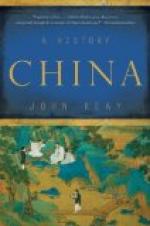If we want to characterize the “Modern Times” by one concept, we would have to call this epoch the time of the emergence of a middle class, and it will be remembered that the growth of the middle class in Europe was also the decisive change between the Middle Ages and Modern Times in Europe. The parallelism should, however, not be overdone. The gentry continued to play a role in China during the Modern Times, much more than the aristocracy did in Europe. The middle class did not ever really get into power during the whole period.
While we will discuss the individual developments later in some detail, a few words about the changes in general might be given already here. The wars which followed Huang Ch’ao’s rebellion greatly affected the ruling gentry. A number of families were so strongly affected that they lost their importance and disappeared. Commoners from the followers of Huang Ch’ao or other armies succeeded to get into power, to acquire property and to enter the ranks of the gentry. At about A.D. 1000 almost half of the gentry families were new families of low origin. The state, often ruled by men who had just moved up, was no more interested in the aristocratic manners of the old gentry families, especially no more interested in their genealogies. When conditions began to improve after A.D. 1000, and when the new families felt themselves as real gentry families, they tried to set up a mechanism to protect the status of their families. In the eleventh century private genealogies began to be kept, so that any claim against the clan could be checked. Clans set up rules of behaviour and procedure to regulate all affairs of the clan without the necessity of asking the state to interfere in case of conflict. Many such “clan rules” exist in China and also in Japan which took over this innovation. Clans set apart special pieces of land as clan land; the income of this land was to be used to secure a minimum of support for every clan member and his own family, so that no member ever could fall into utter poverty. Clan schools which were run by income from special pieces of clan land were established to guarantee an education for the members of the clan, again in order to make sure that the clan would remain a part of the elite. Many clans set up special marriage rules for clan members, and after some time cross-cousin marriages between two or three families were legally allowed; such marriages tended to fasten bonds between clans and to prevent the loss of property by marriage. While on the one hand, a new “clan consciousness” grew up among the gentry families in order to secure their power, tax and corvee legislation especially in the eleventh century induced many families to split up into small families.




